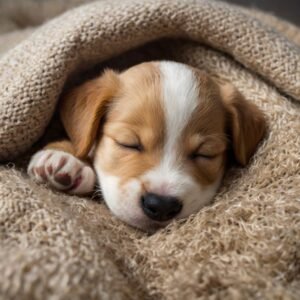Why Does My Dog Twitch in Her Sleep? Understanding Canine Sleep Movements
Introduction
🐕 Paw-picked Topics, 🐶 Sit, Stay, Read!
- 1 Introduction
- 2 The Science Behind Dog Sleep and Twitching
- 3 Why Does My Dog Twitch While Sleeping?
- 4 When Should You Be Concerned About Twitching?
- 5 How to Help Your Dog Sleep Comfortably
- 6 Conclusion
- 7 5 Relevant Questions and Answers
- 7.1 Is it normal for dogs to twitch while sleeping?
- 7.2 How do I know if my dog is having a seizure or just twitching?
- 7.3 Why do puppies twitch more in their sleep?
- 7.4 Should I wake my dog up if she’s twitching in her sleep?
- 7.5 Can diet or exercise affect a dog’s sleep twitching?
- 7.6 Share this:
- 7.7 Related
Have you ever watched your dog sleep and noticed her paws twitching, legs moving, or even soft whimpers escaping her mouth? Many pet owners wonder if these twitches are normal or a cause for concern. This article dives into why dogs twitch in their sleep, the science behind it, and when to worry.
The Science Behind Dog Sleep and Twitching
Dogs experience sleep cycles similar to humans, including deep sleep and REM (rapid eye movement) sleep. During REM sleep, brain activity increases, leading to involuntary muscle movements, often seen as twitching.
The Role of REM Sleep in Dogs
Just like humans, dogs go through REM sleep, the stage where dreaming occurs. The brain remains highly active, causing muscle twitches, eye movements, and sometimes vocalizations.
Twitching as a Normal Reflex
Twitching is a natural response during sleep, helping dogs process daily experiences. It’s more common in puppies and senior dogs due to their developing or aging nervous systems.
Why Does My Dog Twitch While Sleeping?
Twitching can happen for various reasons, from dreaming to neurological activity. Understanding these reasons can ease concerns and help determine if the twitching is normal.
Dreaming About Daily Activities
Dogs relive their daily experiences in dreams, which may explain why their legs move as if they’re running or playing in their sleep.
Muscle Development in Puppies
Puppies twitch more frequently during sleep because their nervous system is still developing. This involuntary movement helps strengthen their muscles as they grow.
Aging and Neurological Changes
Senior dogs also twitch more often due to changes in their nervous system. Aging affects motor functions, making these movements more noticeable.
Temperature Regulation and Sleep Cycles
Dogs may twitch as a way to regulate body temperature. Just as humans shiver, these involuntary movements may help maintain warmth during sleep.
When Should You Be Concerned About Twitching?
While sleep twitching is typically harmless, excessive or abnormal twitching can indicate underlying health issues. Knowing when to be concerned can help protect your dog’s well-being.
Seizures vs. Normal Twitching
Seizures can sometimes be mistaken for sleep twitching. Seizures last longer, involve rigid movements, and may cause loss of consciousness. If you notice this, consult a vet immediately.
Signs of Pain or Discomfort
If your dog twitches excessively while awake or shows signs of discomfort, pain, or stiffness, it could be a symptom of neurological problems or joint pain.
Other Sleep Disorders
Some dogs experience sleep disorders, including REM sleep behavior disorder, which causes intense movement and vocalization. If the twitching disrupts sleep, a vet visit may be necessary.
How to Help Your Dog Sleep Comfortably
Ensuring your dog sleeps soundly can minimize excessive twitching and improve overall well-being.
Provide a Comfortable Sleeping Environment
A cozy dog bed in a quiet, temperature-controlled space helps dogs feel secure and reduces disturbances during sleep.
Maintain a Consistent Sleep Routine
Keeping a regular bedtime routine with adequate exercise during the day can improve sleep quality and reduce restlessness.
Monitor for Changes in Twitching Patterns
Occasional twitching is normal, but if your dog suddenly twitches excessively or violently, document the behavior and consult a veterinarian.
Conclusion
Twitching in a sleeping dog is usually nothing to worry about—it’s a sign of deep, restorative sleep. However, if you notice unusual patterns, seizures, or signs of distress, it’s best to seek veterinary advice. Understanding your dog’s sleep habits helps ensure they rest peacefully and remain healthy.
5 Relevant Questions and Answers
Is it normal for dogs to twitch while sleeping?
Yes, twitching is normal during REM sleep and usually indicates that a dog is dreaming or processing daily activities.
How do I know if my dog is having a seizure or just twitching?
Seizures involve rigid movements, foaming at the mouth, and loss of consciousness, while sleep twitching is brief and natural.
Why do puppies twitch more in their sleep?
Puppies have an underdeveloped nervous system, so their muscles react more during sleep as they grow and develop coordination.
Should I wake my dog up if she’s twitching in her sleep?
No, it’s best to let your dog sleep unless she appears distressed. Waking abruptly may cause confusion or anxiety.
Can diet or exercise affect a dog’s sleep twitching?
Yes, regular exercise and a balanced diet contribute to better sleep patterns, reducing excessive twitching or restlessness at night.
Your message has been sent
Discover more from doggylovershub.com
Subscribe to get the latest posts sent to your email.

Pingback: 7 Unbelievable Reasons Why Did My Dog Pee on My Bed? - doggylovershub.com